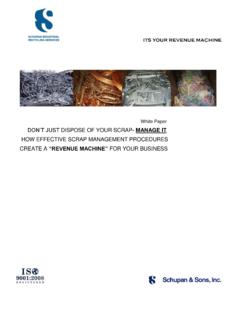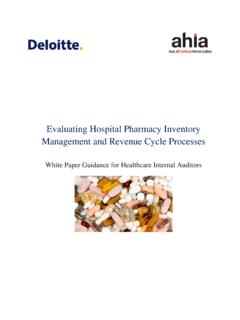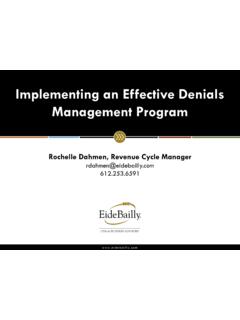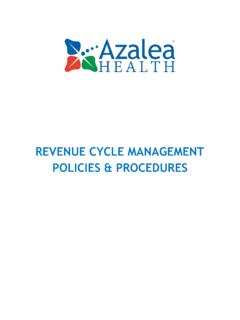Transcription of REVENUE CYCLE MANAGEMENT
1 REVENUECYCLEMANAGEMENTBest Practices GuideREVENUE CYCLE MANAGEMENTI ntroduction ..3 What is RCM? ..4 How does RCM differ from traditional billing? ..5 How can a practice measure financial health? ..6 Days in accounts receivable ..6 Clean claims ratio ..7 Net collections ratio ..8No longer just back office ..10 Front office responsibility ..11 Clinician responsibility ..11 Integrated clearinghouse ..12 Patient responsibility ..13 Value-based payment models ..14 What are value-based programs? ..15 How are physicians paid under these programs? ..15 How is quality measured? ..15 How is cost measured? ..16 Specific value-based programs ..16 How will value-based models affect RCM? ..16 Healthcare s ICD-10 opportunity and challenge: Are you leaving money on the table?
2 18 The post-ICD-10 REVENUE challenge ..19 Back office staff is spending more time checking codes, taking them away from reworking claims..19 Increased denials caused by incorrect coding/lack of specificity ..19 Increased documentation activities ..20 RCM vendors ..22 Considerations for using an RCM vendor ..23 Does an RCM vendor make sense for your practice?..23 TABLE OF CONTENTSREVENUE CYCLE MANAGEMENTREVENUE CYCLE MANAGEMENT : FINANCIAL STABILITY FOR THE FUTURE OF HEALTHCAREI ntroductionThe critical role of effective REVENUE CYCLE MANAGEMENT (RCM) is unprecedented in healthcare. As multiple regulatory initiatives converge with existing demand for faster billing cycles and cost containment, provider organizations are facing a perfect storm of clinical and financial challenges.
3 For many practices, the struggle to collect patient responsibility balances is a concern extending throughout the practice. Beginning with front office knowledge gaps limiting a staff s ability to collect monies owed and extending to a lack of proactive MANAGEMENT among back-office personnel to ensure payers and patients follow through with payment, practices are leaving valuable REVENUE on the table. Payment delays can be attributed to a host of issues, including inaccurate coding to the more severe issue of rejected or denied claims that can negatively impact the bottom , ineffective approaches to RCM are the culprit. An August 2014 Healthcare Finance article revealed that even some of the most prominent healthcare systems experience significant losses, primarily within outpatient areas of service, and there can be a 20-25 percent loss in REVENUE in certain clinical departments.
4 Timely REVENUE CYCLE processes are critical to future success and positioning, especially in light of the rise of high-deductible health plans (HDHPs) and the increasing number of patients responsible for their own healthcare costs. To better position for future reimbursement challenges, practices must embrace new RCM models and best practices to improve patient number of patients with HDHPs and health savings accounts has grown 15 percent annually for several years and now stands at million people. It s a trend that is expected to continue, and practices that maintain the status quo in terms of RCM will most likely see a decline in purpose of this guide is to educate provider organizations about evolving challenges to RCM and teach best practices for improving REVENUE collections.
5 Providers will learn how to effectively train staff and apply processes that promote REVENUE collection and improve overall financial health. To better equip providers with the tools needed to successfully navigate today s reimbursement landscape, we will also introduce Greenway REVENUE Services, an RCM partnership that touches every practice function from the front desk to the back office to help manage REVENUE CYCLE from initial patient encounter to collection and beyond. Two icons will be used next to section takeaways, indicating the target for that particular Billing Managers 3 Focus on capturing outpatient charges. Healthcare Finance News. August8, 2014. 2 Januar y 2013 Census Shows Million People Covered by Health Savings Account/High-Deductible Health Plans.
6 Washington America s Health Insurance Plans. June 2013. In the last six months, we ve found they ve really helped us with our reimbursements, said Lorena Maunez, billing administrator with South Bay OB-GYN. We ve increased our REVENUE , and we re excited to see what the future brings with RCM. Optima Women s Health attributes much of its success with RCM to Greenway REVENUE Services team-oriented approach. I absolutely love having an RCM team. That s the keyword: team, said Vandna Jerath, , FACOG. With a team approach, different people have different roles you have an account manager; you have a person who works on the collections; you have a person who works on the charges and the payment posting. Everybody is specialized in what they do. Greenway REVENUE Services knows the nuances of billing for different specialties such as OB-GYN, neu-rology, gastroenterology, cardiol-ogy, pediatrics, internal medicine, orthopedics and pulmonology.
7 The teams offer the tools and training practices need to: Track claims data Ensure accurate and timely claims submission Boost collection rates Optimize billing practicesWHAT IS RCM?What is RCM? | 5 WHAT IS RCM?In simple terms, RCM refers to the steps that healthcare organizations must take to receive payment for services rendered. Historically viewed as a straightforward back-office function, RCM now touches every aspect of a practice. A complete RCM strategy is comprised of three main functions: 1) Generate REVENUE : Practice survival and sustainability depend on the ability to generate REVENUE . By reducing gaps and inefficiencies in scheduling to maximize reimbursement, practices can achieve this goal, but it requires a proactive approach to both scheduling and capture of all necessary patient information and copays up front.
8 When this function of REVENUE CYCLE is optimized, practices can increase their REVENUE by minimizing the number of no ) Capture REVENUE : Once a patient is called from the waiting room, the clinical encounter begins and extends through the time a patient leaves the appointment. The activity that occurs during this timeframe is foundational to a practice s ability to capture REVENUE and must be thoroughly recorded. Accurate and complete documentation of services rendered and proper coding of those services is required to receive payment at the highest ) Collect REVENUE : In general terms, back office billing functions enable a practice to collect REVENUE and round out the RCM CYCLE . Included in this category are the steps associated with billing, posting and collection of payments and should be viewed by practices as the last step of the RCM does RCM differ from traditional billing?
9 Within traditional fee-for-service care delivery models, billing was characterized by the tasks and functions performed in the back office and was not often viewed as a shared responsibility between front office, back office and clinical staff. Today, billing strategies must evolve and mature within provider organizations to reflect clinically driven RCM models that proactively address payment even before a patient enters the office example, clinically driven RCM would involve conducting eligibility checking before a patient arrives in the office. But it s not just about financial aspects. Clinically driven RCM takes an overall proactive approach to patient health, including reaching out to patients to remind them when it s time for check-ups, services and procedures that may be required to maintain control over chronic conditions, such as diabetes and high blood pressure.
10 Takeaways Practices should not make the mistake of believing REVENUE CYCLE MANAGEMENT only applies to the back office. Front office, back office and clinical staff all play an important role in bringing in REVENUE . Only 62 percent of practices review delinquent healthcare s lean, quality-driven healthcare climate continues to unfold, REVENUE CYCLE depends on the complete and accurate documentation of patient information, beginning at the point of registration and extending through the clinical documentation process. One single gap in data can significantly impact REVENUE streams. For instance, if the front office staff is unable to get all the patient information required for payment or fails to check for eligibility, the downstream impact can be significant billing delays or irreversible claim denials.






